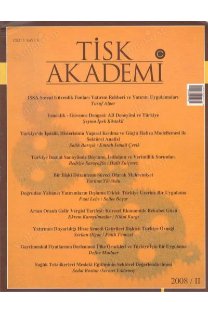Türkiye için sürdürülebilir kalkınma Skoru Geliştirilmesi
Sürdürülebilir kalkınma kavramı, doğal kaynakların tükenmeye başlamasıyla birlikte ortaya çıkmış ve bir takım önlemler alınmaya ve politikalar oluşturulmaya başlanmıştır. Sürdürülebilir kalkınma kavramı geliştikçe, GSYH gibi geleneksel göstergeler yetersiz kalmış ve ortaya farklı göstergeler çıkmış ve bu gösterge setleri geliştikçe GSYH ağır ve hantal bir yapıya dönüşmüştür. Kaliteli politikalar üretebilmek için karar vericilere karar alma sürecinde yardımcı olmak amacıyla doğru ve özet bilginin sağlanması önemlidir. Bu yüzden göstergeler, sürdürülebilir kalkınma politikaları için önemli karar destek sistemi haline gelmiş ve karar vericilere ve politika yapıcılara bu göstergelerden özet bilgi sağlamak için çeşitli metodlar geliştirilmiştir. Bu çalışmada, sürdürülebilir kalkınma göstergeleri kullanılarak, gösterge toplulaştırma metodlarından biri olan temel bileşenler analizi yardımıyla, Türkiye için 1990-2007 dönemini kapsayan sürdürülebilir kalkınma endeksi oluşturulmuştur.
Constructing sustainable development score for Turkey
The concept of sustainable development has arisen with the deplation of natural resources and a set of measures and policies were began to build. As the concept of sustainable development developed, traditional indicators such as GDP had became inefficient and many different indicators were proposed. As this indicator sets grow, their structure became complicated and bulky. To produce policy in high quality for decision makers, it is important to provide brief and accurate information to help them in their decision process. For that reason, those indicators became important decision support system and various methods were developed to provide brief information to policy and decision makers. In this study, Turkey’s sustainable development index for 1990-2007 were constructed by using sustainable development indicators by means of one of the indicators aggregation method which is principal component analysis.
___
- Alfsen, K. H. ve Saebo, H. V. (1993). Environmental Quality Indicators: Background, Principles and Examples from Norway. Environmental and Resource Economics. 3, 415-435
- Atabek A. (2005). A Composite Leading Indicator for The Turkish Economic Activity. Central Bank of The Republic of Turkey. 13, 10 Eylül 2009 tarihinde http://www.tcmb.gov.tr/ yeni/ evds/ yayin/ kitaplar/kitapcikistatistik.pdf adresinden ziyaret edildi.
- Avrupa Komisyonu (2005). Avrupa Konseyi Sürdürülebilir Kalkınma Stratejisi. Avrupa Topluluğu Resmi Basım Ofisi. Brüksel
- Boisevert, V., Holec, N. ve Vivien, D. (1998). Valuation for Sustainable Development: Methods and Policy Indicators. Cheltenham: Edward Elgar Publishing Ltd.
- Bradbury, R. (1996). Are Indicators Yesterday's News? Proceedings of the Fenner Conference Tracking Progress: Linking Environment and Economy Through Indicators and Accounting Systems. Sydney: University of New South Wales
- Callens, I. ve Tyteca, D. (1999). Towards Indicators of Sustainable Development for Firms. Ecological Economics. 28(1), 41-53
- European Comission (2004). EU Member State Experiences with Sustainable Development Indicators. Brussel: Office for Official Publication of the European Communities
- Farsari, Y., Prastacos, P. (2002). Sustainable Development Indicators: An Overview, in Citizens. Sustainable Development, Environment, Foundation for Mediterranean Cooperation. Athens, Greece
- Gustafsson, K., Longeran S., Ruitenbeek H.J. (1999). Selection and Modelling of Sustainable Development Indicators: A Case Study of the Fraser River Basin. Ecological Economics. 28(1), 117-132
- Hair, J. F., Anderson, R. L., Tatham, R. L., Black, W.C. (1998). Multivariate Data Analysis. New Jersey: Prentice Hall
- Hardi, P., Barg, S. (1997). Measuring Sustainable Development: Review of Current Practice, International Institute for Sustainable Development. Ontarino: Industry Canada
- Heycox, J. (1999). Integrating Data for Sustainable Development: Introducing the Distribution of Resources Framework, Novartis Foundation Symposium 220: Environmental Statistics -Analysing Data For Environmental Policy. London: John Wiley & Sons
- Jollife, I.T. (1986). Principle Component Analysis. New York: Springer-Verlag
- Karpuz, S. (2002). Sürdürülebilir Kalkınmanın Zaman Yolculuğu. İktisat İşletme ve Finans. 198, 9-12
- Lohani, B. ve Todino, G. (1984). Water Quality Index for Chao Phraya River. Journal of Environmental Engineering. 110, 1163–1176
- Luxem, M. ve Bryld, B. (1997). Introductory Box: the CSD Work Programme on Indicators of Sustainable Development. New York: John Wiley & Sons on behalf of the Scientific Committee on Problems of the Environment (SCOPE): 6-12
- Manly, B. (1994). Multivariate Statistical Methods: a primer. London: Chapman & Hall
- Meadows, D. (1998). Indicators and Information for Sustainable Development. USA: The Sustainability Institute
- Opschoor, H. (2000). Ecological Footprint: Measuring Rod or Metaphor? Ecological Economics. 32, 363-365
- Sharma, S. (1996). Applied Multivariate Techniques. New York: John Wiley & Sons
- United Nation (1995). Work Programme on Indicators of Sustainable Development of the Commission on Sustainable Development. New York: United Nations
- United Nations (2007). Indicators of Sustainable Development: Guidelines and Methodologies. Newyork: United Nations Publication
- Van Den Bergh, J. (1996). Ecological Economics and Sustainable Development. Cheltenham: Edward Elgar Publishing Limited
- Wackernagel, M., Onisto, L., Bello, P. (1997). Ecological Footprint of Nations. Mexico: Centro de Estudias parala Sustentabilidad
- Walz, R., Block, N. (1996). Further Development of Indicator Systems for Environmental Reporting - Summary of Results Germany: Fraunhofer Institute for Systems and Innovation Research
- Williams, M. R. (1994). Use of Principal Component Biplots to Detect Environmental Impact. Statistics in Ecology and Environmental Monitoring. Dunedin: University of Otago Pres
- ISSN: 1306-6757
- Yayın Aralığı: Yılda 2 Sayı
- Başlangıç: 2006
- Yayıncı: Türkiye Isveren Sendikalari Konfederasyonu
Sayıdaki Diğer Makaleler
Türkiye için sürdürülebilir kalkınma Skoru Geliştirilmesi
Türkiye açısından likidite tuzağının tanımlanması ve çözümlenmesi
Mehmet. Cem BAYDUR, Bora SÜSLÜ
Bireysel emeklilik Yatırım fonlarının işlem hacmine etki eden faktörlerin analizi
TURHAN KORKMAZ, HASAN UYGURTÜRK, İsmail Emrah ÇEVİK
Türkiye ekonomisinde enflasyon ve üretim değişkenliği değiş-tokuş ilişkisinin dinamik analizi
